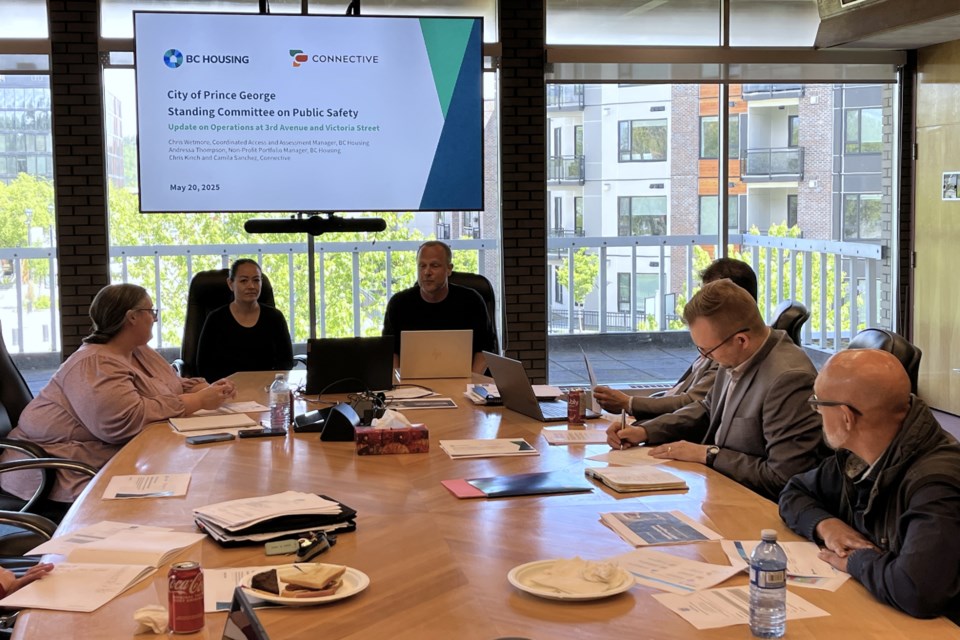Phase two of construction to build supportive housing at the former North Star Inn at 1550 Victoria St. is expected to be complete this fall, Prince George’s Standing Committee on Public Safety heard at its Tuesday, May 20 meeting.
At the meeting, representatives from both BC Housing and non-profit Connective provided updates on their operations in Prince George.
For Connective, that included updates on both 1550 Victoria St. and the transitional housing facility that opened in January at the intersection of Third Avenue and London St.
Representatives Chris Kinch and Camila Sanchez said the Victoria Street facility, which began accepting tenants on May 21, 2024, currently has 54 of 60 units occupied.
When phase two finishes this fall, 33 more units will open, giving the facility 93 total units.
At the Third and London facility near Moccasin Flats, Sanchez said, 34 of 42 units are currently occupied by tenants.
A difference between the two facilities, she said, is that the Third and London facility is meant to be a stepping stone for people to stay as they get ready to transition to supportive or independent housing.
“At supportive housing sites like Victoria Street, tenants are under the residential tenancy act,” Sanchez said.
“Just like any tenant in the private market, they are afforded rights under that piece of legislation. At Third Avenue and London and other transitional programs, residents are not under a tenancy agreement but rather a program.”
Sanchez brought up three success stories at Connective facilities, including those of two tenants who granted permission for their stories to be told.
The first, a man named Brian, was quoted as saying he had spent three and a half years in a shelter and had been struggling to find a stable place to stay since 2017.
After moving into the Third Avenue facility, he said he’s “finally in a place where I don’t have to be out in the cold anymore. I have somewhere to eat. I can take showers and I no longer have to worry about how I smell. What I really appreciate is that this place supports people who have been pushed aside. Being here has helped me grow a lot.
The other two success stories were from the Victoria Street facility. The first was the community garden there, which Sanchez said was started by a resident who came there from Moccasin Flats.
The last story was of a woman referred to as DW, who moved into the facility with a life-threatening infection and an addiction to illicit opioid drugs.
Since then, her infection has healed, she has gone through treatments, she has moved into private housing and recently completed her first year of studies at the College of New Caledonia. The hope is that her partner still at the Victoria facility will eventually be able to join her, the committee heard.
After the end of their presentation, Mayor Simon Yu asked whether there would be any difference between the already open housing at Victoria Street and the new phase two units.
Kinch said they would operate under a similar funding model targeting individuals experiencing or at risk of homelessness.
BC Housing representatives Chris Wetmore and Andressa Thompson provided an update on the Homelessness and Encampments Action Response Teams (HEART) and Homelessness and Encampment Action Response Temporary Housing (HEARTH) programs running in Prince George.
Wetmore said a lot of their work started in the late summer and fall of 2023 with conversations with partnering organizations like Northern Health and that Prince George was the first community in Northern BC to get HEART and HEARTH programs going.
He said the programs’ goal is to address unsheltered homelessness and encampments as well as the safety, health and well-being of people who are in shelters and outdoors.
HEARTH, Thompson explained, is a newer initiative aimed at diversifying the housing continuum across the province.
That includes identifying sites that can be turned into new temporary or permanent assets and aligning those efforts with other permanent housing and shelter investments.
Thompson said that to ensure safety at their sites, they have 24-7 staffing, provide direct phone numbers to neighbours in case of emergency, regular property maintenance, cleaning, perimeter checks and use environmental design as a method of crime prevention.
Kinch talked about how BC Housing selects clients to receive a space at its facilities through a process called co-ordinated access and assessment.
Clients go through a triage and intake process to assess their vulnerability and needs to help match them with available housing and supports. BC Housing also considers who is admitted into each facility to ensure that they remain healthy communities.
This process is informed by the knowledge of other service providers in the community as well as their relationships with clients.
When BC Housing was first organizing the Victoria Street and Third Avenue facilities, Kinch said they wanted to utilize the connections people formed when they stayed overnight at emergency shelters and create a list of prioritized clients from there.
However, Kinch said, they also had to think of Moccasin Flats and how the people there might not have been accessing shelters and account for the need to find units for them as well.
Coun. Brian Skakun thanked BC Housing for its work in Prince George and said one of the things that the city has focused on is that communication by the organization needs to convey accurate information early on when purchasing and developing projects like one in College Heights.
In response to a question from Coun. Ron Polillo, Kinch said that BC Housing outreach workers helped complete a point-in-time homelessness count that was carried out last November, though they did not lead the process.



